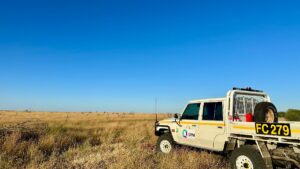QEM’s Julia Creek renewables plan draws quality bidders

QEM has shortlisted three well-credentialled bidders for its planned renewable energy project. Pic: via Getty Images
QEM continues to progress the plan to use renewable power for its Julia Creek vanadium and oil shale project in Queensland with the shortlisting of three non-binding indicative bids.
Bids were received from ACCIONA Energía, Enel Green Power, and a joint bid from Origin Energy and Energy Estate – all experienced power companies – for the development, ownership and operation of up to 1 gigawatt (GW) of renewable energy from a hybrid wind and solar farm directly adjacent to the project.
Monitoring equipment set up by QEM (ASX:QEM) has already proven that the site at Julia Creek receives sufficient wind and sunlight for such a plant to be viable.
Not only will this be one of Queensland’s largest renewable energy projects, it also has the potential to provide cheaper power for Julia Creek and contribute to both the state and Federal Government renewable energy and emission reduction targets.
“QEM has prioritised the design and development of the renewables project with the primary objective of obtaining cheaper electricity for the Julia Creek Project,” managing director Gavin Loyden said.
He added that Queensland Premier Annastacia Palaszczuk stated at the World Mining Congress that the State Government would invest $5 billion to build CopperString 2032, which will connect the North West Minerals Province – where critical minerals will be mined and processed, with the largest renewable energy zone on the east coast of Australia affirming the company’s work to date on the renewables project.
“The Queensland Government has committed to the roll-out of its Queensland Energy and Jobs Plan and to legislate its renewable energy targets of 60% by 2030 rising to 80% by 2035,” he added.
“To put the QEM renewables project in context, there were 6GW of large-scale wind and solar projects in Queensland when the Plan was launched last year. By 2030, the Government projects it will require 16GWs of wind and solar projects and 25GWs by 2035,” he said.
Renewables plan integral to CopperString
Further highlighting the potential of QEM’s planned renewable energy project, Powerlink Queensland director of operations for CopperString Colin Langton said the scale of the company’s plans made it integral to the overall CopperString project.
“With the high quality and enormous potential scale of renewables in the area, the North and North West is well positioned to become the future powerhouse of Queensland,” he noted.
The 1,100km CopperString 2.0 transmission line will connect what the Australian Energy Market Operator (AEMO) calls the “best co-located wind and solar resources in Eastern Australia” with the North West Minerals Province – where Julia Creek is located – providing projects in the area with renewable energy.
Construction is expected to support 800 direct jobs over six years and thousands of new jobs in critical minerals mining, manufacturing, and construction of renewables.
Julia Creek and renewables
QEM will commence commercial negotiations with the shortlisted companies this month as definitive contracts will need to be ultimately agreed at the conclusion of the commercial negotiation process with the selected party.
It also continues to progress the 249.6km2 Julia Creek project, which has a resource of 2,850Mt grading 0.31% vanadium pentoxide, with 360Mt in the higher confidence Indicated category as well as a best estimate (2C) Contingent Resource of 79 million barrels of oil contained within its shales.
Vanadium is classed as a critical mineral – with priority for development and investment – by the Australian Government due to its use in vanadium redox flow batteries (VRFBs) that are expected to play a significant role in the transition to renewable energy.
VRFBs use vanadium-ions in the electrolyte solutions and are considered safer, more scalable, and longer lasting than their lithium-ion counterparts with a lifespan of more than 20 years.
Vanadium is also used in steel to improve tensile strength, reduce weight and improve weather resistance.
The vanadium market is forecast to grow at a compound annual growth rate of 10.2% to $2.36bn in 2025 due to demand growth for VFRBs, which are expected to account for about 23% of the market by 2030 compared to the current 4%.
With 31% of the world’s undeveloped vanadium resources but no domestic production as yet, Australia has the opportunity – like it does with many other mineral commodities – to be a significant player in this space.
A role that QEM is keen to help play with its proposed renewables-powered Julia Creek project.
This article was developed in collaboration with QEM, a Stockhead advertiser at the time of publishing.
This article does not constitute financial product advice. You should consider obtaining independent advice before making any financial decisions.
Related Topics
UNLOCK INSIGHTS
Discover the untold stories of emerging ASX stocks.
Daily news and expert analysis, it's free to subscribe.
By proceeding, you confirm you understand that we handle personal information in accordance with our Privacy Policy.








